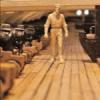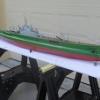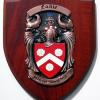-
Posts
13,088 -
Joined
-
Last visited
Reputation Activity
-
 druxey got a reaction from Martin W in SS Kaiser Wilhelm der Grosse 1897 by Mirabell61 - FINISHED - scale 1:144 - POF - first German four stacker of the Norddeutscher Lloyd line
druxey got a reaction from Martin W in SS Kaiser Wilhelm der Grosse 1897 by Mirabell61 - FINISHED - scale 1:144 - POF - first German four stacker of the Norddeutscher Lloyd line
Beautifully executed, Nils! I would have been tempted to fake the bolts.
-
 druxey reacted to System13 in HMS Atalanta 1775 by tlevine - FINISHED - 1:48 scale - from TFFM plans
druxey reacted to System13 in HMS Atalanta 1775 by tlevine - FINISHED - 1:48 scale - from TFFM plans
I am SO VERY sorry for you, and pray she has a gentle time. I didn't know her and I already know I will miss her.
Rocky the dog, as pictured in my avatar was 148 lbs and 14 years old. We had to let him go a year ago last April, and I still tear up.
We planted a dogwood over him and I find myself some days talking to a bush.
If I didn't live far out in the country my neighbors would think I was a Druid
-
 druxey reacted to Mirabell61 in SS Kaiser Wilhelm der Grosse 1897 by Mirabell61 - FINISHED - scale 1:144 - POF - first German four stacker of the Norddeutscher Lloyd line
druxey reacted to Mirabell61 in SS Kaiser Wilhelm der Grosse 1897 by Mirabell61 - FINISHED - scale 1:144 - POF - first German four stacker of the Norddeutscher Lloyd line
Build log part 2
I know it sounds strange to start making the propellers where the hull is not even on the slipway, but I was wondering if I could make them from brass, as they are a typical detail, in the way they were designed 118 years ago......., and as I`ve never seen such model props on the model market, it would be a pitty if I had to fit regular model brass props
I fell in love with these elegant stern lines, designed for speed
here some of the detail parts, in total there are 38 to be made single parts per prop, port- and stb. props rotate counterclockwise with appr. blade twists
raw hub with mounted, drilled and slotted calottes to take up the blades. The slot orientation is set with card template angle jig. The hub raw material is 8 mm squarebar, with centerline boring and M3 thread
blades soldered on and brushed over, the soldering per gas tourch was quite tricky
started to fit the resembled blade fastening bolts with distance sleeves and hexagonal dome nuts. Here six bolts (in actual would be 8 or 10, but that was to tricky for me to drill at that scale...
The actual props had a diam. of 6800 mm, resulting in 47,2 mm model scale 1:144
without bolts....
with bolts
the first prop took me 2 days to make, the second 1,5 day (learncurve)
here original design drawing with 3-blade hub
Nils
-
 druxey reacted to Gaetan Bordeleau in conservation wax
druxey reacted to Gaetan Bordeleau in conservation wax
Beeswax dangerous fact or myth? Here is what I just read on Internet;
Yes, beeswax becomes slightly corrosive when exposed to UV. It's because it's a biological material and UV degrades the molecule releasing natural acids.
In my opinion, the corrosive effects only really matter on a really long term scale and with fragile museum items. New work such as ours won't have the capilliary system of damage and corrosion that ancient pieces have so the risk of new acidic compounds entering the piece on a microscale is not such a concern.
It's the reason microcrystalline and renaissance wax was invented because the V&A realised this fact after a century of applying beeswax to protect the nation's most precious and ancient artifacts that they had, unbeknownst to them, been applying slow acting acid.
-
 druxey got a reaction from dafi in Thinking things trough, the gunport lids
druxey got a reaction from dafi in Thinking things trough, the gunport lids
I don't know whether this helps the discussion or not, but hinge knuckles on sweep port lids are on the forward side in contemporary models.
-
 druxey got a reaction from robin b in Thinking things trough, the gunport lids
druxey got a reaction from robin b in Thinking things trough, the gunport lids
I don't know whether this helps the discussion or not, but hinge knuckles on sweep port lids are on the forward side in contemporary models.
-
 druxey reacted to wyz in HMS Atalanta 1775 by tlevine - FINISHED - 1:48 scale - from TFFM plans
druxey reacted to wyz in HMS Atalanta 1775 by tlevine - FINISHED - 1:48 scale - from TFFM plans
Toni, I'm sorry to hear you may have to put your dog to sleep. As a dog owner I know that's the hardest thing to do, but it's the ultimate gesture of love shown to your pet. You never want to see them suffer. I don't look forward to the day when I will have to make that decision for my dog Toby.
-
 druxey got a reaction from AnobiumPunctatum in HMS Atalanta 1775 by tlevine - FINISHED - 1:48 scale - from TFFM plans
druxey got a reaction from AnobiumPunctatum in HMS Atalanta 1775 by tlevine - FINISHED - 1:48 scale - from TFFM plans
My sympathy and condolences to you, Toni. It's not an easy decision to make: been there, done that.
-
 druxey reacted to jml1083 in Echo by jml1083 - 1:48 - Cross-Section
druxey reacted to jml1083 in Echo by jml1083 - 1:48 - Cross-Section
Today I started to raise frames. I made a jig out of 1/8" plexiglass to help make this process as accurate as possible.
The profile of the keel structure is cut into the bottom of the face piece. The grid you see on the face was made in MS-Excel to no particular scale. I printed the grid out on self-stick Mylar.
This first photo is from the front and shows the Deadflat0 frame in place.
The second photo is the back of the jig from an 45° angle to show how everything lines up. The blue tape is just to make the pieces stand out a bit. After applying the Mylar grid to the front and cutting the base so the keel is exactly dead center I built the back supports. These are nothing more than 2 bases with an upright glued to the center. For these it is important to make sure everything meets at exactly 90°. The front of the uprights is perfectly flush with the front of the bases. Once the glue has had time to really set I went about attaching the back supports to the back of the face piece. To do this I slide both supports into the keel which I used to set the proper gap. With both support pieces in place I ran a line of glue along the base where the supports meet the face piece. After a couple of seconds I made sure the face piece was in contact with the front edge of each support and ran a line of glue down these joints.
When I'm raising a frame I use a small bar clamp to gently squeeze the keel assembly with the bases of the support pieces. This keeps the whole thing from moving as I raise the frame.
The third photo is another view of the back of the jig, this time looking straight on.
Because everything is square to everything else this makes a handy way to raise frames and check their alignment. The scale of the grid doesn't matter, the lines are just used to check symmetry. The jig is used on a piece of glass to make sure the base I'm working on is dead flat.
Once the glue has dried on one frame the jig can be slid back to make room for the next frame.
Up next is raising the other 11 frames then I'll install the gun port sills, sweep sills and scuppers.
-
 druxey got a reaction from src in conservation wax
druxey got a reaction from src in conservation wax
It's mildly acidic, Frankie. Conservator's wax is pH neutral.
-
 druxey got a reaction from Piet in HMS Vulture 1776 by Dan Vadas - FINISHED - 1:48 scale - 16-gun Swan-class sloop from TFFM plans
druxey got a reaction from Piet in HMS Vulture 1776 by Dan Vadas - FINISHED - 1:48 scale - 16-gun Swan-class sloop from TFFM plans
The door, Dan, the door! Please close it so both Pud and you may live out your natural life spans. Your riggers did a good running repair, though.
-
 druxey got a reaction from Jack12477 in HMS Vulture 1776 by Dan Vadas - FINISHED - 1:48 scale - 16-gun Swan-class sloop from TFFM plans
druxey got a reaction from Jack12477 in HMS Vulture 1776 by Dan Vadas - FINISHED - 1:48 scale - 16-gun Swan-class sloop from TFFM plans
The door, Dan, the door! Please close it so both Pud and you may live out your natural life spans. Your riggers did a good running repair, though.
-
 druxey reacted to allanyed in Gaps between planks - are they possible to fix
druxey reacted to allanyed in Gaps between planks - are they possible to fix
Pasanax
It may be too late for your current model, but the edges of the planks need to be tapered so they fit properly. Do a search of this forum and you will see it has been brought up in the past and there are sketches of what I described in words. If it was me, I would remove the planks and start again, but that is just one opinion. The caulking lines would only be the width of a piece of tissue or paper which is described in the planking tutorials, and the gaps you show are quite a bit more from what can be seen in your photo.
Allan
-
 druxey reacted to JerseyCity Frankie in Maximum length of a deck plank
druxey reacted to JerseyCity Frankie in Maximum length of a deck plank
Another factor would be the available roads the timber would be brought down over. A 60' tree trunk would be nearly impossible to manage. the "low hanging fruit" of trees easily within reach of any shipyard would have been exhausted quite quickly and from then on it would become more and more difficult to get lumber, suppliers having to go deeper and deeper into the hinterlands and then bring timber back over what would likely have been the entire length of most available roads. Roads that at best would be very windy very circuitous and primitive by our standards.
-
 druxey got a reaction from mtaylor in HMS Vulture 1776 by Dan Vadas - FINISHED - 1:48 scale - 16-gun Swan-class sloop from TFFM plans
druxey got a reaction from mtaylor in HMS Vulture 1776 by Dan Vadas - FINISHED - 1:48 scale - 16-gun Swan-class sloop from TFFM plans
The door, Dan, the door! Please close it so both Pud and you may live out your natural life spans. Your riggers did a good running repair, though.
-
 druxey got a reaction from GLakie in Work table height?
druxey got a reaction from GLakie in Work table height?
If you can afford it, there are electrically operated tables that you can alter height on to suit whatever you are working on at that moment. Great when rigging!
-
 druxey got a reaction from Bindy in Maximum length of a deck plank
druxey got a reaction from Bindy in Maximum length of a deck plank
The issue is not so much how tall a tree was available to yield long lengths, but the practical issue of handling the planks. Certainly long straight pieces were used for keels and similar items, but handling a length of plank, manoeuvring it in and out of a steam chest, bending and hanging it by manpower alone.... My reading suggests that these planks would be between 24' 0" and 28' 0" and no longer than about 30' 0".
-
 druxey got a reaction from Canute in Maximum length of a deck plank
druxey got a reaction from Canute in Maximum length of a deck plank
The issue is not so much how tall a tree was available to yield long lengths, but the practical issue of handling the planks. Certainly long straight pieces were used for keels and similar items, but handling a length of plank, manoeuvring it in and out of a steam chest, bending and hanging it by manpower alone.... My reading suggests that these planks would be between 24' 0" and 28' 0" and no longer than about 30' 0".
-
 druxey got a reaction from trippwj in Maximum length of a deck plank
druxey got a reaction from trippwj in Maximum length of a deck plank
The issue is not so much how tall a tree was available to yield long lengths, but the practical issue of handling the planks. Certainly long straight pieces were used for keels and similar items, but handling a length of plank, manoeuvring it in and out of a steam chest, bending and hanging it by manpower alone.... My reading suggests that these planks would be between 24' 0" and 28' 0" and no longer than about 30' 0".
-
 druxey got a reaction from mtaylor in Antic Warships
druxey got a reaction from mtaylor in Antic Warships
No, Mark. The project I recall was one by a British university and consisted of a short half-section amidships. The Greek Olympias (long before their current austerity measures!) may have been based on the results of that experiment.
-
 druxey reacted to Maury S in Cutter Cheerful 1806 by Maury S - 1:48 - POB
druxey reacted to Maury S in Cutter Cheerful 1806 by Maury S - 1:48 - POB
Laying out the planks below the wales. I used tick strips every other bulkhead starting from deadflat and ran a batten at the mid points (10 planks down) from stem to where the square tuck joins the stern. That seems the most critical alignment of the planks. Since it was fair, I marked all the bulkheads with a dark line. Same exercise on the other side.
Maury
-
 druxey got a reaction from mtaylor in Antic Warships
druxey got a reaction from mtaylor in Antic Warships
Wasn't there a trireme project about 20 years ago in England? A section of what they thought was the layout and construction was built, full size, and manned to see if the oars could work without fouling each other.
-
 druxey reacted to pasanax in Antic Warships
druxey reacted to pasanax in Antic Warships
Well the funny thing is that I actualy study history, but there are no real experts on classical studies at my university. We had the best classical department in the country but it got disbanded due to their internal affairs. Very sad thing.
I guess I could share here what I found out so far about the crew of the trireme. Basicaly all the info you can find about greek naval warfare is about the trireme.
Ancient warships were not built for large scale sailing so they always had to be near the shore. So sailing would be done during the day, and during the night the ships would dock and the crew would eat and sleep on the shore. So combat was never conducted in the open sea, and before they would engage they would leave anything they don't need on the shore, including the mast that would be taken down. When the ship was sailing all of the top deck crew would be sitting down, centered in the middle, so the ship doesen't lose its stability it needs for rowing (wich was fairly easy to happen).
Classical greek ships were based on speed and manuverability. They focused on ramming the enemy ship and tried to sink it that way, avoiding any boarding actions. Ramming another vessel required a lot of skill and training, and only the most experienced crew were able to do more compicated manouvers (like crushing oars of the enemy ship). With that approach the Greeks won their most famous naval battle, the battle of Salamis. They managed to defeat the enemy that outnumbered them with much larger ships, but manouverability and speed proved to be better than sheer size and strenght.
The trireme was praised by one of the ancient historians as a true depiction of the greek society. All of the crew in the lower decks were free men (this is atleast tought to be), and above them stood the men that were in the society above them. All of them, the rich and the poor, working together for a goal as true democracy that they treasured. Apparently the rowers were free men and it was their profession to be one. It required a lifetime of training to do effectivly some of the complicated manouvers. The image of rowers bound in chains under the crack of a whip was constructed in the middle ages, since the Venetians use to do that. So the same view was about Romans and all of the rowers of ancient times, but the reality could be much different.
Now the number and consistancy of the crew onboard the trireme seems to vary depending on the situation. There are accounts that say a trireme had 200 men onboard, including 170 oarsmen, 16 hoplites, 4 archers, a ,,captain'' (i am keeping it simple and not going into real terms), deck officers, some ondeck sailors and a flutist. It is rather interesting how they only had 16 hoplite infantry on board, one would think what could they do with 16 men if they went into melee. Well, as far as I realise it, they avoided melee combat on seas so it was not needed to concentrate on heavy infantry on board. That is the reason why the Romans managed to defeat them at sea. Greeks had a far superior knowlidge of naval warfare, and the Romans never mastered it.
But the Romans did a smart thing and turned naval combat into land combat by constructing a bridge with a hook that they mounted on their ships (corvus). With that they would board the ships that rammed them, and since they put a significant number of infantry on board, those ,,16'' hoplites would soon find themselves in a difficult situation.
Now I couldn't find any info about a ship that I am building - the bireme. I am guessing that the crew of a bireme would be similar to the trireme, only in fewer numbers. Trireme had more than triple rowers than the bireme, but there is no info about the crew (so i sepose the deck crew numbers are atleast half of the trireme).
-
 druxey reacted to Maury S in Cutter Cheerful 1806 by Maury S - 1:48 - POB
druxey reacted to Maury S in Cutter Cheerful 1806 by Maury S - 1:48 - POB
Over the last few days, I've applied six well-thinned coats of black paint (Model Expo Hull Black) to the wales. I don't have Chuck's skills at hand painting without going past the edge, so I taped it with Tamiya masking tape. Very little bleed-thru and most of that scraped-off easily.
Maury
-
 druxey got a reaction from Canute in Work table height?
druxey got a reaction from Canute in Work table height?
If you can afford it, there are electrically operated tables that you can alter height on to suit whatever you are working on at that moment. Great when rigging!











